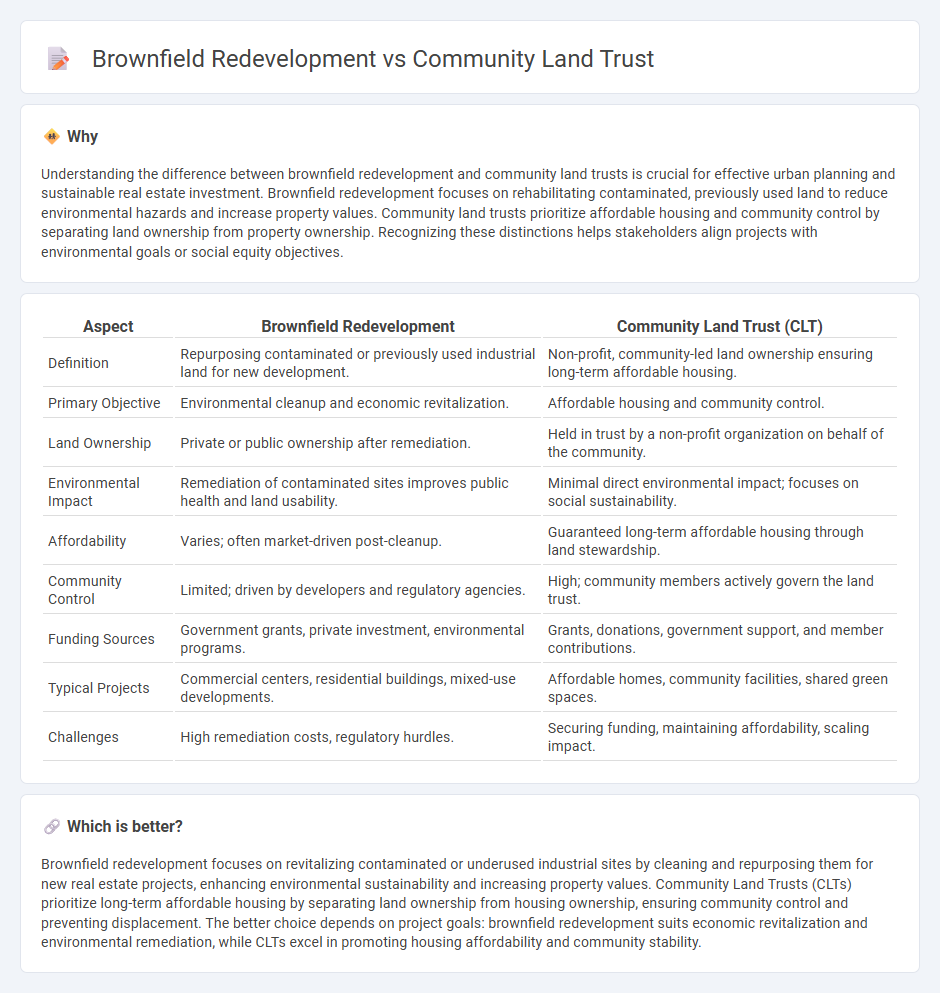
Brownfield redevelopment transforms underutilized or contaminated urban sites into valuable real estate, boosting local economies and reducing environmental hazards. Community land trusts preserve affordable housing by separating land ownership from homeownership, ensuring long-term community control and preventing displacement. Explore how these innovative real estate models shape sustainable urban development.
Why it is important
Understanding the difference between brownfield redevelopment and community land trusts is crucial for effective urban planning and sustainable real estate investment. Brownfield redevelopment focuses on rehabilitating contaminated, previously used land to reduce environmental hazards and increase property values. Community land trusts prioritize affordable housing and community control by separating land ownership from property ownership. Recognizing these distinctions helps stakeholders align projects with environmental goals or social equity objectives.
Comparison Table
| Aspect | Brownfield Redevelopment | Community Land Trust (CLT) |
|---|---|---|
| Definition | Repurposing contaminated or previously used industrial land for new development. | Non-profit, community-led land ownership ensuring long-term affordable housing. |
| Primary Objective | Environmental cleanup and economic revitalization. | Affordable housing and community control. |
| Land Ownership | Private or public ownership after remediation. | Held in trust by a non-profit organization on behalf of the community. |
| Environmental Impact | Remediation of contaminated sites improves public health and land usability. | Minimal direct environmental impact; focuses on social sustainability. |
| Affordability | Varies; often market-driven post-cleanup. | Guaranteed long-term affordable housing through land stewardship. |
| Community Control | Limited; driven by developers and regulatory agencies. | High; community members actively govern the land trust. |
| Funding Sources | Government grants, private investment, environmental programs. | Grants, donations, government support, and member contributions. |
| Typical Projects | Commercial centers, residential buildings, mixed-use developments. | Affordable homes, community facilities, shared green spaces. |
| Challenges | High remediation costs, regulatory hurdles. | Securing funding, maintaining affordability, scaling impact. |
Which is better?
Brownfield redevelopment focuses on revitalizing contaminated or underused industrial sites by cleaning and repurposing them for new real estate projects, enhancing environmental sustainability and increasing property values. Community Land Trusts (CLTs) prioritize long-term affordable housing by separating land ownership from housing ownership, ensuring community control and preventing displacement. The better choice depends on project goals: brownfield redevelopment suits economic revitalization and environmental remediation, while CLTs excel in promoting housing affordability and community stability.
Connection
Brownfield redevelopment revitalizes contaminated or underused urban sites, creating opportunities for affordable housing and mixed-use projects. Community land trusts (CLTs) often collaborate in these redevelopment efforts to secure long-term land ownership, ensuring equitable access and preventing displacement. This synergy promotes sustainable urban renewal while maintaining community control and affordability.
Key Terms
Land Tenure
Community land trusts (CLTs) secure long-term land tenure by separating land ownership from housing ownership, ensuring affordable housing remains accessible and resistant to market pressures. Brownfield redevelopment often involves complex land tenure issues, including unclear ownership and contamination liabilities, which can delay or complicate site reuse. Explore how these land tenure models impact sustainable urban development and affordable housing by learning more about CLTs and brownfield approaches.
Environmental Remediation
Community land trusts (CLTs) prioritize long-term affordable housing and community control while incorporating environmental remediation to ensure safe land use, often addressing urban brownfield sites. Brownfield redevelopment focuses primarily on cleaning contaminated properties to enable commercial or residential reuse, emphasizing pollutant removal and regulatory compliance. Explore how these approaches integrate sustainable environmental remediation to revitalize communities.
Affordable Housing
Community land trusts (CLTs) create permanently affordable housing by separating land ownership from homeownership, ensuring long-term price stability and community control. Brownfield redevelopment transforms contaminated or underutilized industrial sites into habitable spaces, often requiring significant environmental remediation but offering opportunities for urban revitalization. Explore the distinct roles these approaches play in expanding affordable housing options and sustainable community development.
Source and External Links
What Is a Community Land Trust? - A community land trust (CLT) is a nonprofit corporation that holds land for a community, removing it from the market and managing it through ground leases to provide affordable housing and other benefits.
Community Land Trusts - Community land trusts are nonprofit organizations that own land and lease it for affordable housing, governed by a board representing leaseholders, community members, and public interests.
Community Land Trusts (CLTs) - The Uprooted Project - CLTs provide affordable housing and community control over land, offering opportunities for low-income residents and qualifying for property tax savings in some regions.
 dowidth.com
dowidth.com